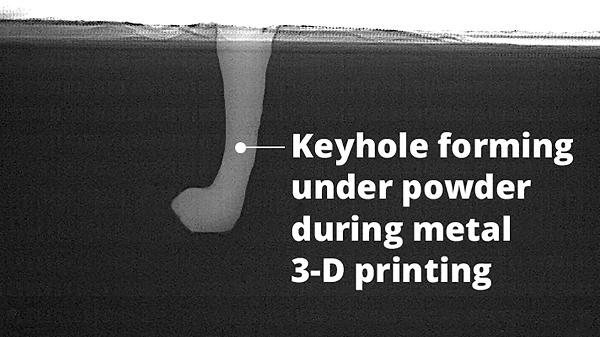- FMA
- The Fabricator
- FABTECH
- Canadian Metalworking
Our Publications
Categories
- Additive Manufacturing
- Aluminum Welding
- Arc Welding
- Assembly and Joining
- Automation and Robotics
- Bending and Forming
- Consumables
- Cutting and Weld Prep
- Electric Vehicles
- En Español
- Finishing
- Hydroforming
- Laser Cutting
- Laser Welding
- Machining
- Manufacturing Software
- Materials Handling
- Metals/Materials
- Oxyfuel Cutting
- Plasma Cutting
- Power Tools
- Punching and Other Holemaking
- Roll Forming
- Safety
- Sawing
- Shearing
- Shop Management
- Testing and Measuring
- Tube and Pipe Fabrication
- Tube and Pipe Production
- Waterjet Cutting
Industry Directory
Webcasts
Podcasts
FAB 40
Advertise
Subscribe
Account Login
Search
Filling holes that form during additive manufacturing
Argonne and Carnegie Mellon work to eliminate gas pockets that weaken 3D-printed parts
- February 28, 2019
- Article
- Additive Manufacturing
Minute keyholes form in metal parts built by the laser powder bed fusion (LPBF) method of additive manufacturing (AM). These tiny gas pockets can lead to cracks and other failures in the final product.
An article published in Science magazine has identified how and when these gas pockets form, as well as a methodology to predict their formation. The article is based on research jointly conducted by Carnegie Mellon University and the U.S. Department of Energy’s Argonne National Laboratory.
“The research in this paper will translate into better quality and better control in working with the machines,” said Anthony Rollett, a professor of materials science and engineering at Carnegie Mellon and one of the paper’s authors. “For additive manufacturing to really take off for the majority of companies, we need to improve the consistency of the finished products. This research is a major step in that direction.”
Until now, manufacturers and researchers did not know much about how the laser drills into the metal, producing cavities called “vapor depressions,” but they assumed that the type of metal powder or strength of laser were to blame. As a result, manufacturers have been using a trial-and-error approach with different types of metals and lasers to seek to reduce the defects.
The research shows that these vapor depressions exist under nearly all conditions in the LPBF process, regardless of the laser or metal used. Even more important, the research shows how to predict when a small depression will grow into a big and unstable one that can potentially create a defect.
The research shows that keyholes form when a certain laser power density is reached that is sufficient to boil the metal. This, in turn, reveals the critical importance of the laser focus in the AM process—an element that has received scant attention so far, according to the researchers.
The team believes the research could motivate makers of AM machines to offer more flexibility when controlling the machines and that the improved use of the machines could lead to a significant improvement in the final product. In addition, if these insights are acted upon, the process for 3D printing could get faster.
That’s “important because 3D printing in general is rather slow,” Rollett said. “It takes hours to print a part that is a few inches high. That’s OK if you can afford to pay for the technique, but we need to do better.”

Image taken under the synchrotron at Argonne National Laboratory shows a keyhole void about to be formed during a metal 3D printing process. With the LPBF process, the printer “drills” a hole into the metal. The scientists used extremely bright, high-energy X-rays to take superfast video—50,000 frames per seconds—and images of the LPBF process (see video).
About the Publication
- Podcasting
- Podcast:
- The Fabricator Podcast
- Published:
- 04/16/2024
- Running Time:
- 63:29
In this episode of The Fabricator Podcast, Caleb Chamberlain, co-founder and CEO of OSH Cut, discusses his company’s...
- Trending Articles
- Industry Events
16th Annual Safety Conference
- April 30 - May 1, 2024
- Elgin,
Pipe and Tube Conference
- May 21 - 22, 2024
- Omaha, NE
World-Class Roll Forming Workshop
- June 5 - 6, 2024
- Louisville, KY
Advanced Laser Application Workshop
- June 25 - 27, 2024
- Novi, MI


























